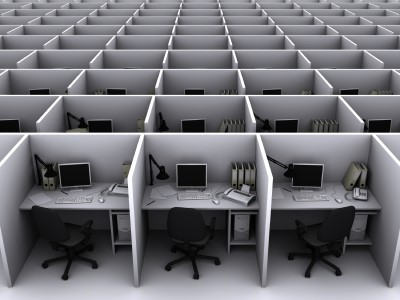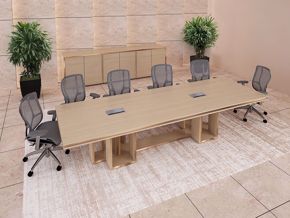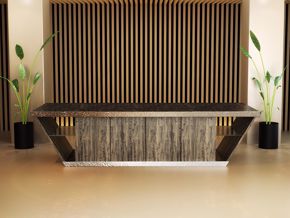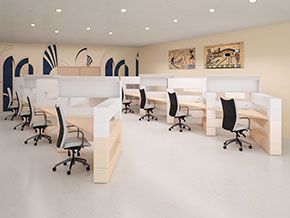In many business environments, thought, design, color and visual amenities are as far removed from each other as Mercury is from Pluto.
Business owners think office environment a waste

I have heard it said many times by decision-makers: “I would rather direct my time and resources in areas that are going to be profitable as opposed to wasting money in office design.”
From interviews, many CEO’s think in similar ways. At first glance, it certainly seems practical to use company resources in ways that will obviously go directly to bottom line profitability. Office workspaces, be it a reception area, open workspace or private offices are generally considered as merely functional workspaces needed for task performance and only occupy a small place in thought or budget considerations.
Environmental discoveries in neuro science
For years, neuro scientist have been researching the affect environment has on human behavior. Universally, (in controlled environments) they have come up with some pretty amazing discoveries. Consider the facts below:
Some years ago, a team of researchers placed hundreds of stamped, addressed envelopes near college dorms and logged how many envelopes actually got mailed. The idea behind this experiment was to see how many small acts of charity actually took place.
What they discovered in brief was; almost all the envelopes in less populated dorms got mailed. Conversely, only 60% were mailed in crowded dorms. What they deduced from this experiment was students residing in high-density environments were less compelled to be thoughtful.
If crowded environments actually affect thoughtful, responsive behavior, what can we extrapolate from these findings in real workplace environments?
Can crowed workplaces affect sales?
When I think of telemarketing environments, there seems to be a general propensity to pack large numbers of sales people into small cubicle spaces by design. On one hand from strictly a geography verses cost scenario, it makes perfect sense. However it begs the question; what is the value of the tradeoff; between volume sales of their people and effective performance?
Taking this research a bit further, they found, when asked, most students told researchers that they think of themselves as a lot different than they actually responded in the environmental situation, when studied. “We imagine that these traits are a set of enduring attributes that sum up who we really are. But in truth, we’re more like chameleons who instinctively and unintentionally change how we behave based on our surroundings.” New York Times published: June 14, 2013
“Environment is more of a predictor of people’s actions then people are of themselves”
Research shows lighting changed environment
Think about this and tell me if you see a connection between environment and behavior. In Scotland, contractors “installed a series of blue lights in conspicuous locations throughout the city. The purpose of the lights was designed to make unsightly districts of the city more attractive, but after just a few short months, crime statistics pointed to an interestingly amazing trend: crime rates had declined in all those areas that were washed in blue lights.
The blue lights simulated what police have on their vehicles, (or blue has a more calming affect) which possibly inferred police could be spying from an obscure location. Interesting, right? But no coincidence! I say that because in 2005, police in Japan copied this experiment by, installing blue lights in high crime locations and got a comparable result: the general crime rate was lower.
People behave in workplaces without knowing
Now, in no way am I suggesting to install blue lights in your workplace to lower crime, but rather to demonstrate that people do respond to their environment. Whether it is a modern reception, an antiquated sales space or blue lights in a crime district, people will respond without being cognitively aware.
But even less obvious interpositions seem to have parallel significances
People behave differently if they feel they are being watched
In England, researcher found that people’s behavior is more likely to be honest when they feel they are being watched. They discovered people were more likely to pay for products listed in a self-service food environment when there was a picture of a pair of eyes on a posted menu board as opposed to flowers. This is what they found.
How environment affects production
On a much more local level, we at 90 Degree Office Furniture discovered that when we changed our office furniture manufacturing policy to require every worker to be responsible for return placement of every tool, screw and material to its rightful location, a designated place for every screw and bracket, bathrooms kept clean etc., that there was a measurable difference in the degree of product care, attention to detail and work do over’s. What we discovered was the environment created a self-demand for innate product perfection and became more and more a personal requirement rather than a company mandate.
Well-behaved people change with environments
In environments where people care little about what it looks and feels like, they give others the authorization to also act in kind. Even people that would not behave badly will find themselves acting in harmony with environments. The heavily debated broken windows theory, demonstrates how people who are otherwise well behaved change habits when surrounded by environments of mediocrity.
“People are people, and they do what they do, even when you think they won’t, and further; even when they think they won’t.”
Workplace environment needed for better results
Workplace environments are places where a collection of people from many backgrounds come together to perform tasks that contribute the whole of the business. How they perform is the responsibility of the owner of the business as well as the workers themselves. Creating a proper workplace environment is job one for every business owner. Giving each worker the tools to how to think and behave are something that requires; direction, thought, planning and proper implementation.










